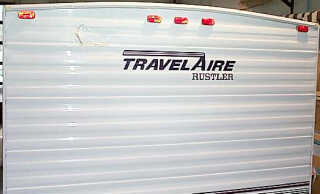Changing Damaged RV Siding
The following pictures demonstrate the procedures for a very simple sheet metal siding repair job. Most repairs are not this simple or easy ... various windows, doors, compartments and other opening will complicate things as will the length of the required metal sheets.
Eight foot long sheets can be handled by one or two people, but sheets of 20 or more feet in length will require three or four helpers and great care must be taken to avoid damaging the metal as it is installed.

This is a relatively simple rv siding metal replacement job and will take about 5 hours to complete. The top two panels are damaged and will be replaced with new matching sheet metal.

First remove the two side mouldings and the top moulding if there is one ...

... and the clearance lights. Pop off the clearance light lenses and remove the two screws - pry up the light
assembly and remove the inner light bulb assembly by turning it 1/4 turn. Some lights may have to be disconnected -
this style does not ...
Remove the staples holding the rv siding metal on - depending on the construction used, the sheet metal may be folded over and stapled from the side over the back, or from the back over the side metal. Take care not to dent or mark the undamaged panels!

Straighten out the folded metal using a putty knife and hammer. The putty knife is inserted behind the metal fold as a backup and the metal carefully hammered straight.

The rv siding sheets are installed one at a time from the top down at the factory. The lower edge of each sheet has a "lock" or folded part that allows the sheet to be stapled at the edges and at every vertical stud in the wall. The top of the next sheet is inserted into the lock and then that sheet is stapled on as described above. This process is repeated to the bottom of the wall where the bottom of the last sheet is usually folded under the wall and stapled in place.

In order to save time, it is often possible to "pop" out a sheet as shown here and in the photo above. Extreme care must be taken to ensure that this sheet is not creased or marred by this operation. This allows the two damaged sheets above to be replaced without removing all the sheets on the wall. Mark the location of the bottom of the first sheet that will be replaced, as shown by the arrow in this picture. The replacement sheet will be stapled in this position so that it will correctly align with the lower sheet.

The staples holding the bottom of the damaged panel are now accessible and can be removed at this time ...

This picture shows the first damaged panel removed from the trailer ... the bottom edge of the next higher panel is marked with a line and arrow to locate it's position.

This picture shows both the top two rv siding panels removed.

The new metal sheets are shipped in a crate to prevent shipping damage. Often the crating and shipping charges are more than the cost of the metal!

The old sheet is carefully laid over the new sheet in order to trace out the shape required and also the locations of the clearance light access holes ...

... to make sure everything will line up correctly.

The shape of the top curve is trimmed using tin snips ...

... and a hole saw is used to drill out the access holes for the clearance lights ...

The sheet is trimmed and ready to be installed ...

... and then stapled into position using the arrow marks for correct positioning ...

... the next sheet is installed, stapled into the correct position and the lower sheet "popped" back into the lock. Clearance lights and mouldings are re-installed using new putty tape and the decal will be applied at a later time.